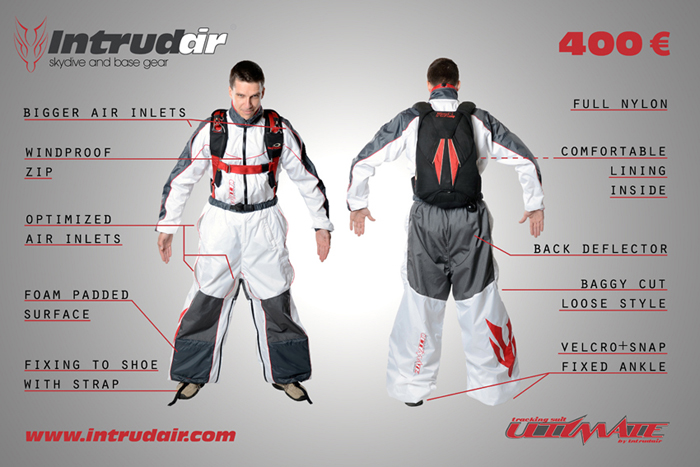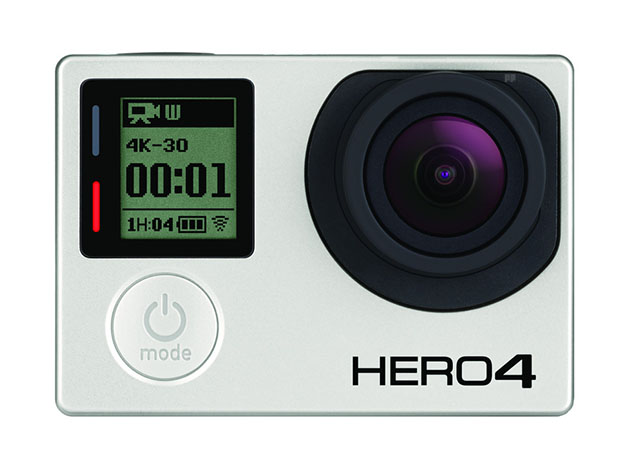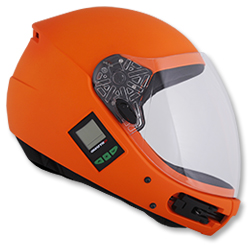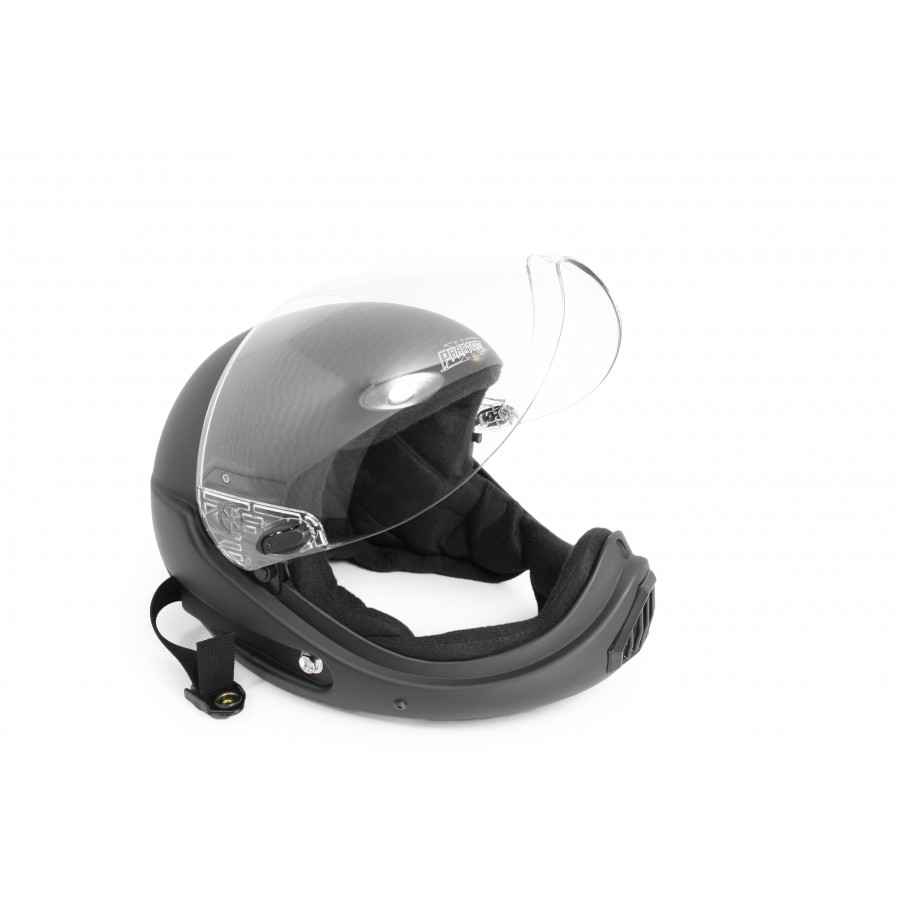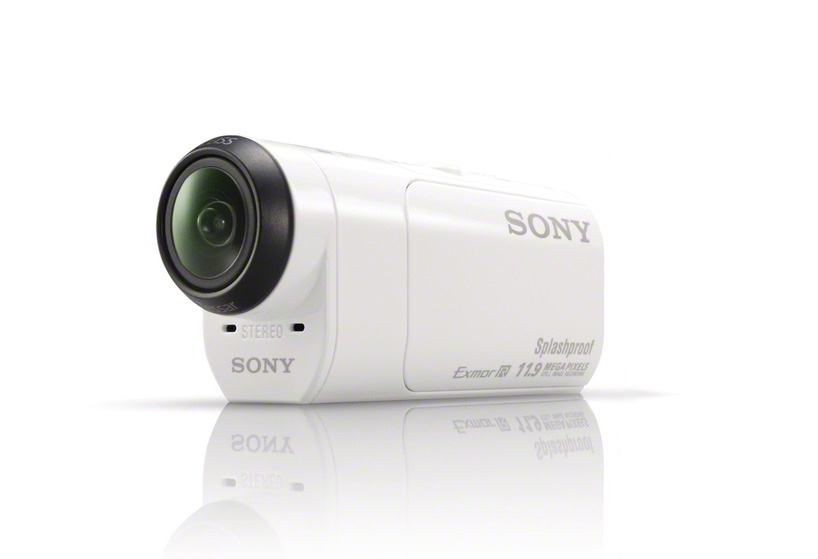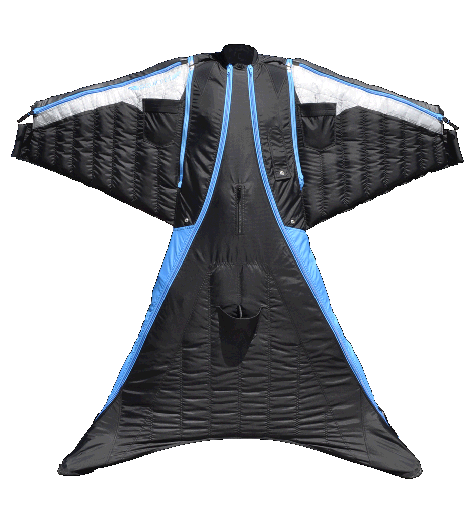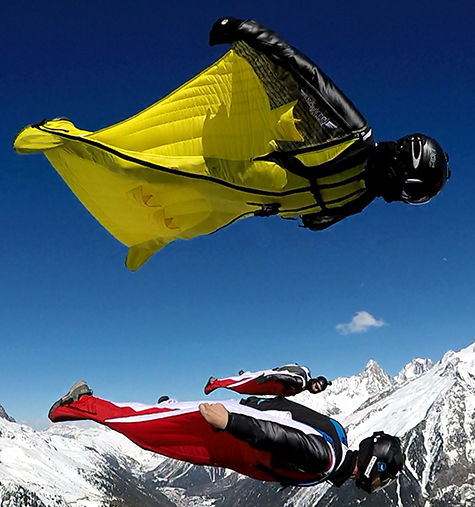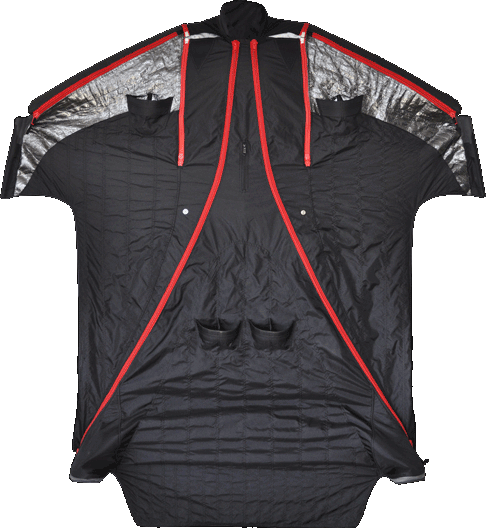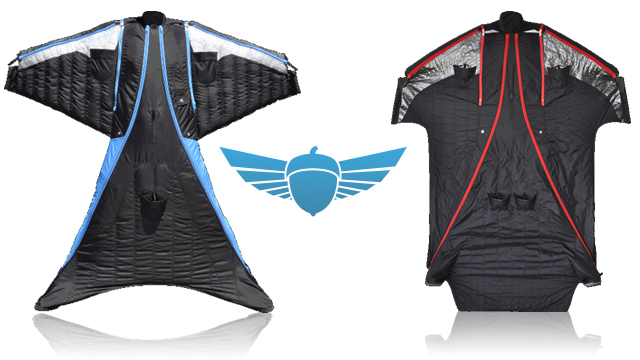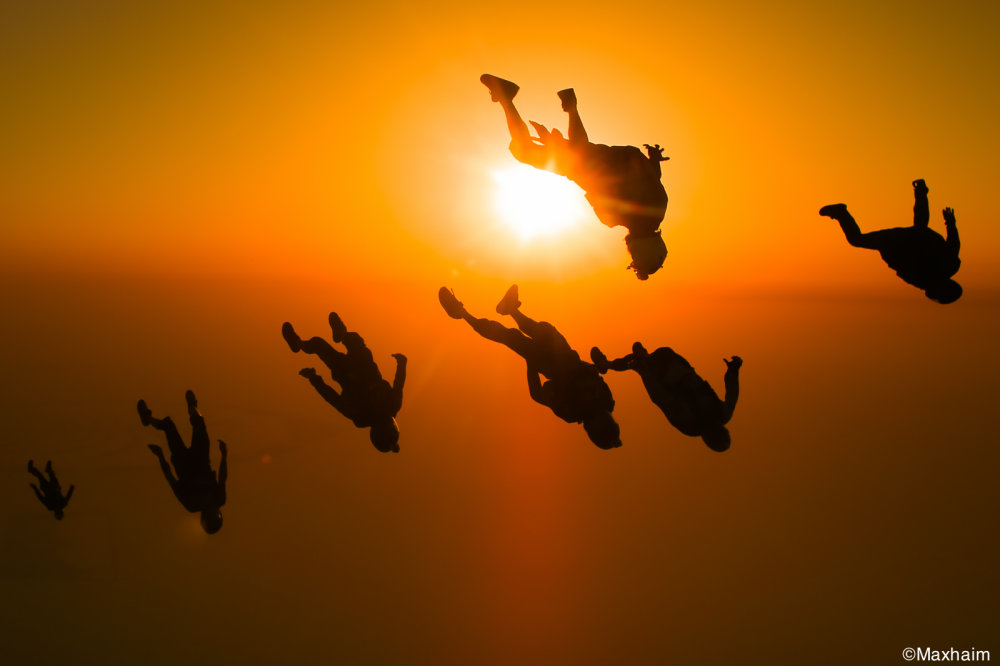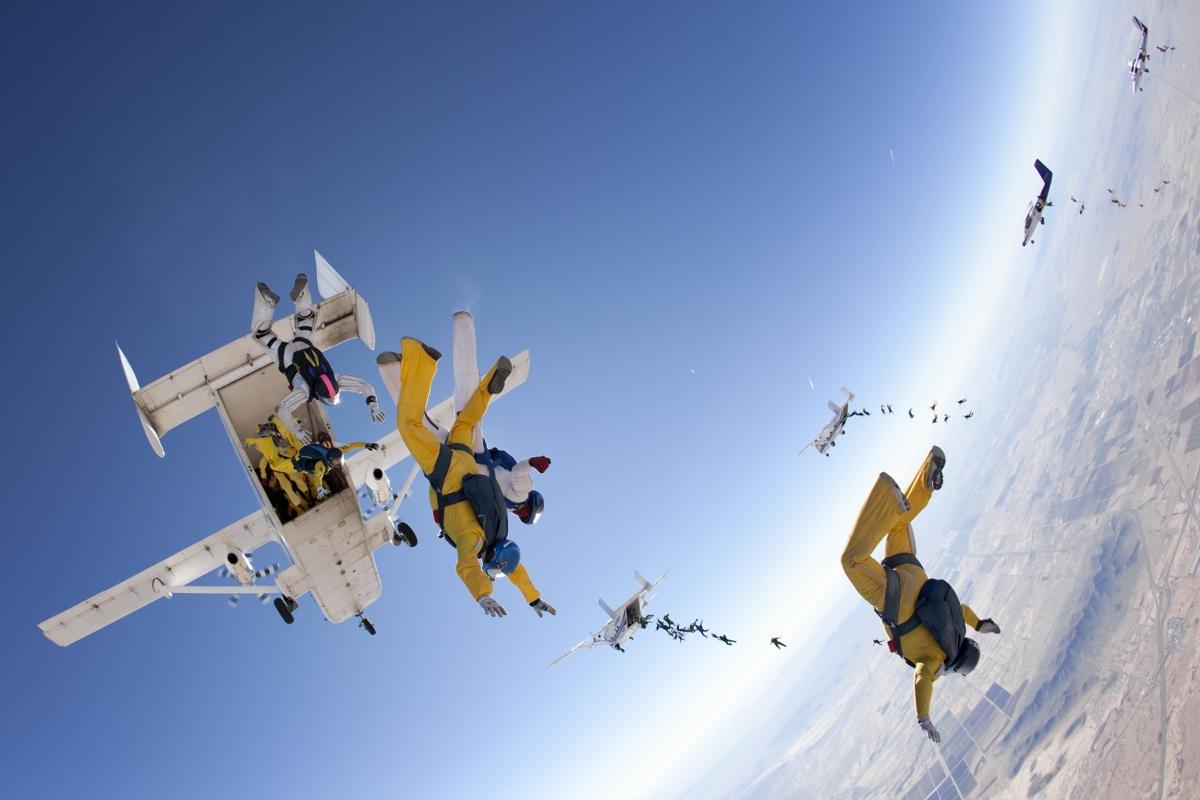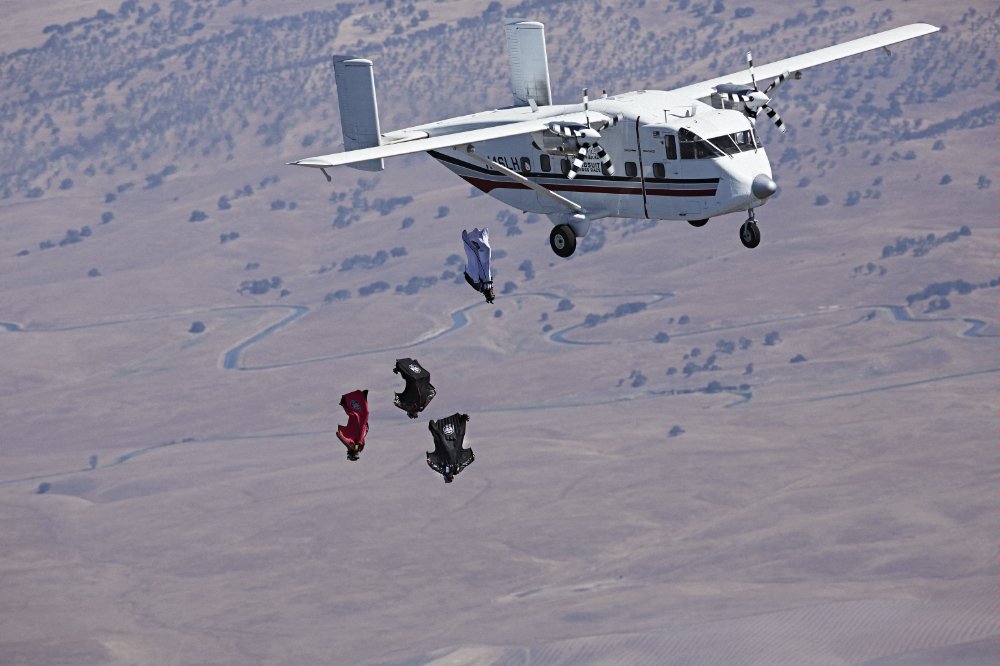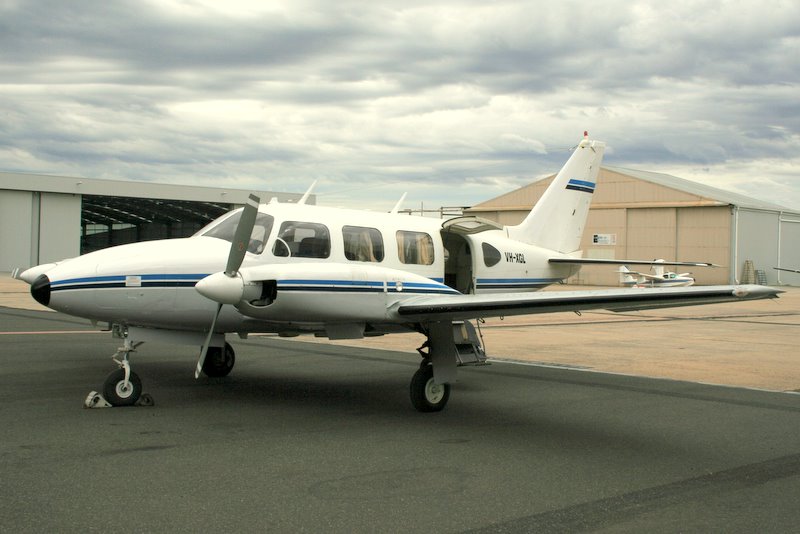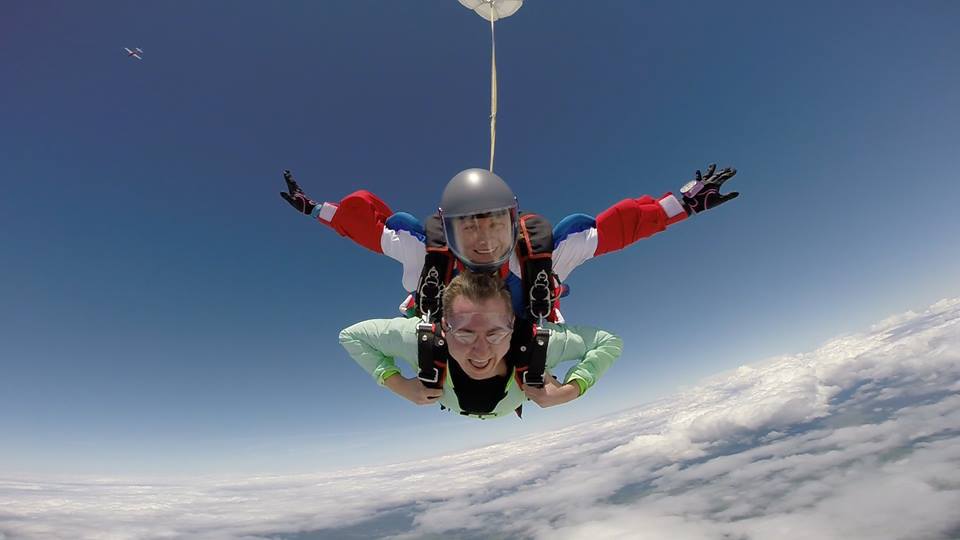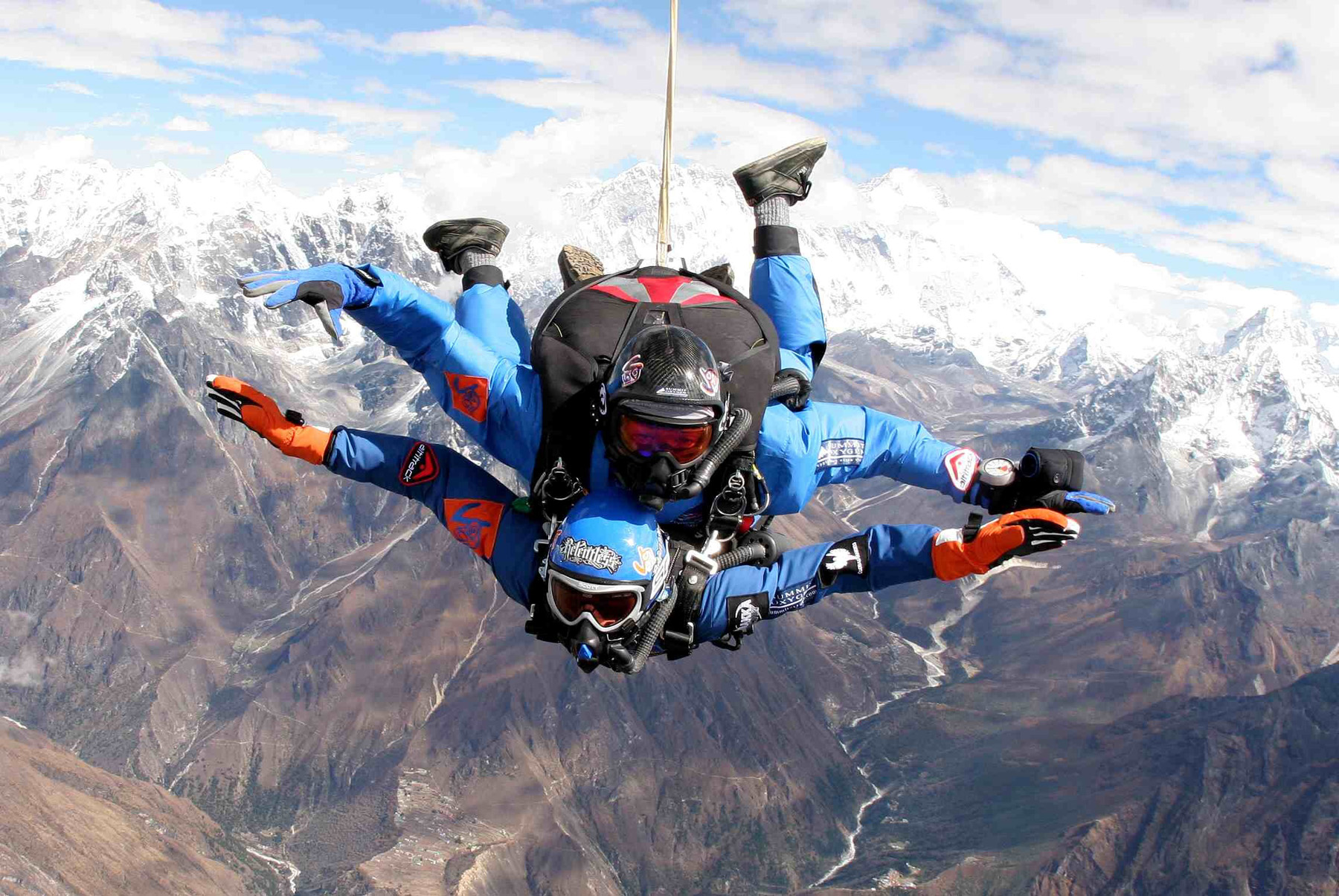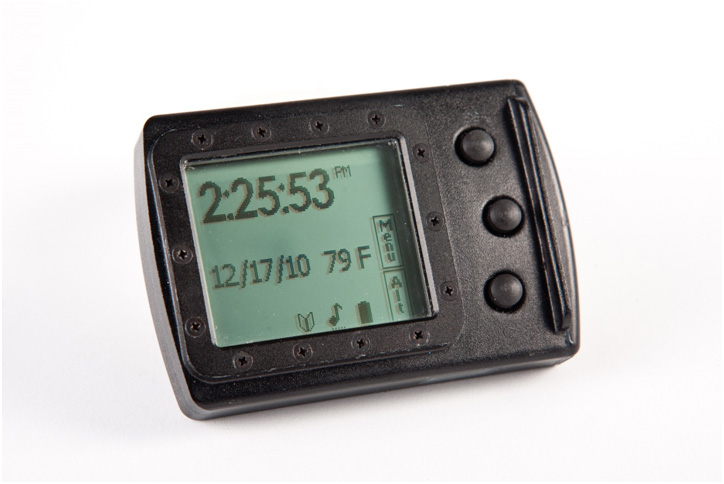-
Content
-14 -
Joined
-
Last visited
-
Days Won
1 -
Feedback
0%
Content Type
Profiles
Forums
Calendar
Dropzones
Gear
Articles
Fatalities
Stolen
Indoor
Help
Downloads
Gallery
Blogs
Store
Videos
Classifieds
Everything posted by admin
-
Only for experienced flyers! Based on experience gathered from our previous suits and feedback provided by professional BASE-jumpers we are proud to introduce our latest high performance tracking suit: THE INTRUDAIR ULTIMATE. The ULTIMATE is a truly powerful tracking suit. Recommended for experienced BASE-jumpers and trackers. The extra loose pants and loose jacket provides a fast yet flat flight. The unique air inlets helps the jumper to go in a tracking position almost immediately. A significant amount of test jumps were crucial to realise and produce the optimum potential of the suits. The tests were specifically designed to develop and achieve the following aspects; ideal positioning of the air inlets, perfect ratio between the pants and the jacket, as well as the prime position of the deflector on the back of the suit, which results rapid inflation and solid pressurization during flight. Technical details: Main material: strong nylon. Wind- and waterproof zip to keep the pressure inside the suit. Pants: The ankles secured with velcro and press stud for maximum safety. Two pockets on the outside for a phone or radio, etc. Cordura knee and bottom is optional if required for hard usage. Jacket: Always with comfortable lining, 2 outside pockets. Thanks to the innovative solution, the reinforced air inlets can not be closed. The diameter of the inlets have been increased. The layout of the inlets also have been optimised.
-
Intrudair's hybrid suits are the DBC series which are 50% skydiving and 50% tunnel flying. This type of suit can be used both places, and it corresponds 100% to the requirements of modern freefly skydiving and either indoor skydiving. By default, the suit has a tight tayloring, and comfortable elastic elements on the joints of your body. The assembly stitching is made of strong nylon yarn in soft smooth sytle. We reinforced the knees with cordura 1000, the bottom patch is optional.
-
GoPro have announced the specs and release date for the highly anticipated Hero 4 action camera, which will come in three models. The new series of GoPros are scheduled for release around the middle of October this year, and will feature the standard GoPro Hero 4, a GoPro Hero 4 Silver and then the top of the range GoPro Hero 4 Black. New Key FeaturesSome of the highlights with regards to the specifications of the new GoPro range is the addition of 30fps recording at 4k resolution that is found with the Black Edition, which sees a big step up from the previous models 4k video recording, which only allowed for 15fps recording at 4k. The increase in frames from the Hero 3 will mean that users will find more versatility with their high resolution video recording. Another exciting new addition is that of a touch screen on the Silver edition. While GoPro has always been a reliable camera with regards to build and video quality, one aspect that many have found lacking has been the usability of the camera menus, which are handled with the on camera buttons and a small display. Now GoPro have gone and added what is likely to be a very welcomed addition in that it has introduced for the first time in the GoPro series, a touch screen which will no doubt allow for easier navigation of the menus, as well enabling the ability to preview your images (worth noting that the Hero 4 claims to have a new interface for quicker menu navigation too). It is however unusual that the touch screen feature is only available on the Silver edition and not on that of the more expensive Black edition, nor the entry level version of the Hero 4. The most likely reason for the inclusion in the Silver edition is that GoPro is marketing the new series towards three general groups of people, and the mid-range target market is more likely to desire the touch screen, without having to purchase the LCD "BacPac" accessory, which sells for another $80. Though of course it is still possible for one to use their smartphone as a remote for the camera. As customary with a new GoPro release, the company has focused on increasing the general image quality achieved and further enhancements have been made on ensuring better quality in low-light. GoPro Hero 4 Black The GoPro Hero 4 Black, is as mentioned above, the top of the range for the Hero 4 series and thus the most powerful of the lineup. A new processor is claimed to be twice as fast as that found in it's predecessor. The Hero 4 Black will not only have video performance enhancements, but also step up the game with far superior audio recording. There are three modes of shooting with regards to field-of-view: Narrow, Medium or Ultra Wide. There will be the ability to manually adjust settings like ISO limit, exposure and colour for both video and photos. The camera will include built-in Wi-Fi and Bluetooth. Waterproofing down to 40 meters will be standard. GoPro are seemingly targeting the Hero 4 Black to those looking for the absolute best quality and features available in an action camera, specifically professional use and dedicated adventure sports enthusiasts who are looking to create high quality video footage using the camera. The Hero 4 Black will cost $500 on release. GoPro Hero 4 Silver The GoPro Hero 4 Silver seems to be targeted to your average action cam user, from the weekend surfer to the seasoned hiker, or even tourist. The touch screen that is included on this model will make it easier to navigate and preview what you've taken. This is especially useful for those who want to use the photographic functions and treat it as both a still camera and video camera. The image sensor on the Silver, like the Black - allows for 12 megapixel images at 30fps. This model is still more than adequate to provide quality video footage and also offers 4k resolution video recording, but only at a maximum of 15fps. With functionality such as Wi-Fi, Bluetooth and Waterproofing being the same as that of the Black, one can see why there is only a $100 price difference between the two. The Silver will sell at around the $400 dollar mark. GoPro Hero 4 The Hero 4, is the entry model for the series and comes in at an extremely affordable $130. It records in full 1080p resolution at 30fps or 720p at 60fps. The sensor of the camera allows for 5 megapixel images, offering 5fps bursts. The market for this entry level camera would be those looking to enjoy the benefits of an HD recording camera, while not having to fork out more than they need to. The use of action cameras in every day life has become exceedingly common and this camera will offer more than enough for a large portion of GoPro users. This camera could also work for those who are perhaps wanting to try something brave with their camera to get a certain shot, but do not want to risk the potential damages to a higher priced model. We haven't seen much video footage yet, so it is difficult to put these models side by side to see exactly what one can expect from each one, and the difference in quality between models - but it will no doubt only be a matter of time before we see what this latest range is capable of.
-
Photo by Ori Kuper | USPA | SDCThis was my 4th year at USPA Nationals (and my 3rd at Skydive Chicago), so when I rolled up to Skydive Chicago on September 12, the day before 4-way FS was scheduled to start, I knew the drill. Get there early in the day before the registration lines get too long. Receive and dispense hugs from your friends from around the country, some of whom you only ever see at Nationals. Manifest for a couple of low-key “get the butterflies out” jumps with your team before chilling out until the briefing and draw that night. Except this year, Mother Nature had different plans. The first two days of Nationals had brought the miserable weather the Midwest is sometimes known for. The dropzone was full of maudlin vertical formation skydiving (VFS) and mixed formation skydiving (MFS) competitors, so some of those hugs were of the “Awww, I feel your pain” variety, as friends who’d trained all year were facing the possibility of weather truncating their competition to only a couple of jumps. The only competition going on was on the ground, with a friendly game of Four Square taking place outside, and a more competitive ($5 buy in) game of Corn Hole inside the hangar. Practice jumps on Friday were out of the question, so we went to bed with those butterflies holding strong, with their only to be exorcised on the first competition jump. Never fear, though, both Mother Nature and the meet management delivered on Saturday morning, with skies dawning clear (and pretty cold), and five Twin Otters ready to go to get not only the 10 4-way VFS and 10 2-way MFS teams in the air, but also get the Nationals’ largest event, 4-way FS (with its 56 teams) rolling. Photo by Ori Kuper | USPA | SDCPausing for a moment to acknowledge what it takes to keep five Otters turning for two days straight, it’s hard not to be impressed by what the host DZs (and the supporting meet team from USPA) pull off every year, even with perfect weather. It’s a massive undertaking, and each time I compete, I’m impressed with how seamlessly it all seems to work (at least from the competitors’ perspective). I know that behind the scenes there’s a giant group of people working long hours to make sure that every part of the operations, from the judging stations to the fuel trucks to the toilets are working as they need to. Five Otters doing two passes per load means a jump run roughly every 2 ½ minutes. Skydive Chicago has a giant landing area, and the winds were favorable for parallel jump runs that still put most if not all of the jumpers in a good position for a safe on-field landing every time. Over my 10 jumps there, I only recall one or two times that we had a delay on jump run for traffic and spacing, and only one off landing (and that might’ve had as much to do with a slightly low pull as with the spot). Photo by Ori Kuper | USPA | SDCSaturday and Sunday brought two near-perfect days of weather, providing Meet Director Bill Wenger with almost enough of a window to complete the full competition for 4-way VFS and 2-way MFS. There was a heroic amount of scheduling Tetris taking place to alternate rounds of the two disciplines, especially considering there was quite a bit of competitor overlap. The vertical flyers competed at an atypical pace for Nationals, collectively agreeing that they’d rather accept shorter-than-required calls for the opportunity to get most or all of the competition rounds in. Saturday ended with MFS finishing five of its scheduled six rounds, and VFS finishing seven of eight, with the winners recognized at a medal ceremony Saturday night. At the same time, all of the 4-way FS competitors got through half their scheduled 10 rounds on Saturday, setting the competition up for an easy finish on Sunday with the predicted great weather. Sunday dawned clear and a hair warmer and a great day of weather allowed the 4-way FS competition to finish up. As Sunday’s jumps wrapped up in the early afternoon, both in the Open and Intermediate categories the race for Bronze came down to the final jump, with a crowd of competitors gathering around the monitors in the hangar to watch the judging of Round 10 live to see who would go home with a medal. Photo by Ori Kuper | USPA | SDCSpeaking of medals, one of the best parts of Nationals is the awards ceremonies, which are scattered throughout the event as each discipline finishes up. There usually aren’t any surprises in the medals – the standings were set as soon as the judges finished their work, but it’s a chance to be recognized in front of your fellow competitors for a job well done. This year’s 4-way FS medal ceremony Sunday evening brought a special opportunity for USPA Director of Competition Jim Hayhurst to recognize someone that anyone who’s ever competed in 4-way has admired – Mark Kirkby – who is retiring from full-time competition with Arizona Airspeed after this Nationals. Typical of Mark, he won’t slow down much as he steps back into the alternate role on Airspeed, and will continue to coach and organize in Arizona and around the world. The enthusiastic and extended standing ovation for Mark showed just what an impact he’s had on the competitive 4-way world in the 20 years since he was a founding member of Arizona Airspeed. I’ve been privileged to jump with and be coached by Mark several times at Skydive Arizona, including my 1000th jump in late 2012, where I managed to talk three of the then-current members of Airspeed into joining me for a 4-way! Like so many of the top names in our sport, he remains ever helpful and humble as he passes on his wisdom to the next generation of skydivers and being part of the crowd that honored him was a great way to end my 2014 4-way experience. About Krisanne Combs: Krisanne Combs is a weekend warrior who has logged 1450 jumps in her 10 years in the sport. She competed in 4-way FS this year as part of 5th Wheel, a Northern California-based team. Krisanne lives in Oakland, California, where she has a paid job for a large health plan, and an unpaid job as staff for two freakishly large male cats. When she’s not in her local skydiving haunts of Skydance Skydiving or iFly SFBay, she’s probably planning her next skydiving trip. More of Ori Kuper's photography can be found on his website and Facebook page.
-
Bringing innovation and precision engineering to full-face helmet design, Square One presents the KISS. A multi-discipline, state-of-the-art, high-performance helmet, the KISS features a 2mm thick polycarbonate lens with full mouth exposure, panoramic visibility and Square One’s NEW patent-pending anti-fog ventilation system. Whether your aerial pleasures find you belly-to-earth or head-down, this unique vent system will greatly reduce fogging in all conditions. The KISS also features a NEW Quick-Tight Latch Closure System utilizing two levers to tighten or loosen the helmet on the user’s head. Simply pop the levers closed prior to exit and your helmet is secure! Square One went one step further and integrated dual audible altimeter pockets with exterior access. Dual pockets allow for critical instrument redundancy and exterior windows simplify the motions of accessing your instruments to set altitudes, recall information, or simply power the device off and on. These technologies combined with our proven Quick Change Lens System render the KISS the most advanced helmet in skydiving today. FEATURES: NEW Patent Pending anti-fog ventilation system NEW Quick-Tight Latch Closure System Dual audible altimeter pockets with exterior access Full mouth exposure Panoramic visibility 2mm thick polycarbonate lens for superior protection
-
The Phantom XV boasts the same great features of the Phantom X, PLUS the Phantom XV has integrated a patent-pending anti-fog ventilation system which allows a small stream of air to enter the helmet and channels this airstream across the inside surface of the lens. This continuous airflow (or airstream) will greatly reduce and virtually eliminate most fogging problems in most conditions. Additional features include: 2MM Thick Polycarbonate Lens: Offers superior protection Opens and closes with ease Anti-fog coated Anti-scratch coated Easy to clean Easy Change Lens System: Change your lens in 30 seconds! No tools required No loose parts No need for super-human strength Intelligent Engineering: Widest field of vision Dual lens locks (1 on each side) Secure audible altimeter pocket Proven tightening system with adjustable snap
-
Sony has unveiled its latest action camera which focuses on reducing size. The Sony Action Cam Mini (HDR-AZ1VR) was announced earlier this month at the IFA 2014 electronics show in Germany. While Sony's action cameras have always been small, the electronic giant decided that they could reduce the size even further by removing the GPS functionality from within the camera and instead moving it to an accompanying wrist-mounted device. The Sony AS30 and Sony AS100 weighed 90 and 67 grams respectively. The new Action Cam Mini weighs in at 4 grams lighter than the AS100, at just 63 grams with the battery included. The size of the camera itself is quite a bit smaller than both the AS30 and AS100 with a Width/Height/Diameter measurement of approximately 24.2 x 36.0 x 74.0 mm, while the AS100 had a height of 46.5mm. The smaller size is going to be good news for skydivers who are looking to minimize the risk of snag for cameras that are helmet mounted. As to be expected the Action Cam Mini will shoot in full HD with options to either shoot at 1080p at 60 or 30fps, or to shoot at 720p with the option for 120 fps slow motion recording. The camera will include an F2.8 Zeiss lens with a 170 degree field of view and an Exmor R cmos sensor. Still photographs can be shot at an impressive 11.9 megapixels. It will also include Sony's trademarked SteadyShot image stabilization and be splash proof, with a waterproof housing included that allows for 5m of depth protection. The wrist mounted device that comes with the Sony Action Cam Mini allows for data transfer between the camera and the internet, allowing users to live stream camera footage. Something else the wrist mount does that may prove invaluable to those who have the camera mounted, is that it both acts as a remote and offers live view. This will allow users to see exactly what is being recorded and adjust body position if needed, to achieve specific angles. It can control up to five cameras at once and will be water resistant. While we have yet to see any footage from this incredibly small camera, if Sony's other action cameras are anything to go by, we can expect a lot from the Sony Action Cam mini. During our action camera shootout we were extremely pleased by the results of the Sony AS100, which took the top spot. Release date for the Sony HDR-AZ1VR is late October. Specifications Image sensor 1/2.3-type back-illuminated Exmor R CMOS sensor with 11.9 megapixels (effective, approx.) Image processor BIONZ X Video formats XAVC S: 1920x1080 60p/50p(50Mbps) 1920x1080 30p/25p(50Mbps) 1920x1080 24p(50Mbps) MP4: PS: 1920x1080 60p/50p (28Mbps), HQ: 1920x1080 30p/25p (16Mbps), STD: 1280x720 30p/25p (6Mbps) SSLOW: 1280x720 120p/100p (6Mbps) VGA: 640x480 30p/25p (3Mbps) HS120(HS100): 1280x720 120p/100p (28Mbps) Lens type ZEISS Tessar® F2.8 Angle of view SteadyShot OFF: approx. 170° SteadyShot ON: approx. 120° Image stabilisation SteadyShot Audio Stereo microphone Data Multi/Micro USB Terminal (Supports Micro USB compatible devices) Wi-Fi/NFC GPS Dimensions WxHxD 24.2 x 36.0 x 74.0 mm (approx.) Media card compatibility MP4: Micro SD/SDHC/SDXC Memory Card (Class 4 or higher), Memory Stick Micro™ (Mark 2) XAVC S: Micro SDXC Memory Card (Class 10)
-
Bonehead composites is proud to introduce our new full face AERO helmet! After six months of intense design work we are finally able to witness its fruition. Features making the AERO the top of the line of skydiving head gear include: High-end vacuum molded carbon fiber composite shell (not plastic!) 2mm molded polycarbonate lens, also available in tinted gray! Scratch resistant and anti-fog lens Widest field of vision on the market that offers an unobstructed view of the jumpers face Perfect for instructors! Compatible with eye glasses Easy to cut away Removable and washable liner Spring loaded CNC aluminum visor locks provide consistent and easy two handed openings and single hand closers with three screws on each side, secure the visor in place. Securing the helmet on incorporates a cord drawn collar and cut away buckle. Collar adjustments are made by simply pulling slack in the cord and re-knotting . The collar is made from wetsuit neoprene and can easily be replace without the need for any messy glue! Velcro and six screw attachment points keep it secure around the shell's parameter. The liner follows our standard line in construction, is removable for washing and has the convenience of audible pockets on both sides. GoPro cameras can be top mounted using our standard mount and options for other cameras will also be available. The AERO makes flying with cameras safe due to its ingeniously simple quick release cutaway! Sizes: X-Small - 21.25" - 21.75" Small - 21.75" - 22.25" Medium - 22.25" - 22.75" Large - 22.75" - 23.25" X Large - 23.25" - 23.75" XX-Large - 23.75" - 24.00"
-
Over the past year we have had a few requests for a wingsuit that is just ridiculously easy to fly. We get it, we hear you, and we like easy, too. The new HATCH is the easiest and most comfortable suit that we have ever flown. The HATCH retains all of the safety and performance features that Squirrel suits have become renowned for, including the RAD system, tri-layer leading edge construction, innie-outie zips, and reinforced inlets. Thanks to the RAD system, the HATCH requires no cutaway cables and allows direct access to your risers and brakes during and after deployment. This is a critical safety feature that no wingsuit should be without. The HATCH leading edge construction is our signature blend of comfort and performance, with a smooth surface in positions of best glide, and unparalleled comfort and access at pull-time. Although it is basically the easiest wingsuit out there, the HATCH is not just a beginner suit. It’s fun, agile, and versatile. More experienced wingsuit pilots searching for a low-surface area suit for beginner backflying and acrobatics and basic flocking applications will love the range and comfort of the HATCH. For pilots and instructors who are searching for the absolute maximum in ease of use for their first jumps and beyond, the HATCH is the answer.
-
The FUNK is our all-around-acro-freestyle-flocking-fun-relaxed-sporty-skydive-wingsuit-thingy. Actually, we're pretty confident that you can tell what this thing is for just by looking at it. In a nutshell, it's our go-to suit for fun-flying in the skydive environment: the FUNK does it all. This is our answer to the many pilots who have been asking us for a suit that fits in the range between the SWIFT and COLUGO. The FUNK has been in development since before the SWIFT launched, and during its evolution we gradually fine-tuned the internal pressure, profile thickness, and stance. We have arrived at a planform that yields a balanced and stable feel while back-flying; many of our test pilots have remarked that it is almost absurdly stable on its back. One of our tasks during development was finding a good balance between stability in belly / backfly positions, while maintaining ease of transition. We think that we have found an excellent compromise, and the FUNK features an extra-long arm-wing zip which allows pilots to tailor the internal pressure to their style of flying. The FUNK's planform necessitates a long and diagonally swept trailing edge on the arm wing, which presents a large opportunity for turbulation as the airflow disconnects here. For that reason, mini-ribs were deemed necessary in the arm wing, but in the end we decided to increase the total number of arm wing cells. This decreased drag at the trailing edge, of course, but also increased general efficiency of the arm wing. These extra ribs do not increase the wing's rigidity – instead, they create a sharper feel when initiating transitions and banking turns. We're very excited to hear what you think of this new suit. We thoroughly enjoyed the development process and we hope you agree that the FUNK is an awesome platform with great agility, range, and ease of use.
-
The Colugo 2 release was delayed until after the RedBull Aces event, where new technology in this exciting suit made its debut and was tested by Squirrel team pilots. Andy Farrington took first place flying a prototype that included key innovations present in this new design, including leading edge mini-ribs and a new hybrid leading edge construction. The new Colugo 2 is significantly smaller in surface area than its predecessor. It features a new arm wing profile and leg wing design, new planform, and a new type of Dacron coated leading edge construction, with a flexible segment at the wrist. We are very excited about this new suit and the delay in releasing it is a direct result of us having a bit too much fun with the testing, and wanting to push the progress as far as possible before releasing it. The core mission for the Colugo 2 is to provide a fast and agile suit for advanced-intermediate to expert pilots. The Colugo 2 is now available for pre-order. We expect the first orders to ship in late August and early September. Please scroll down for more information.
-
Squirrel have recently released two new products to their wingsuit inventory, with an entry level wingsuit called the Hatch and an advanced wingsuit called the Colugo 2. The Colugo 2 was announced for release in June, but was delayed until the Redbull Aces event, which saw the testing of technology included in the suit. Andy Farrington who was flying a Squirrel prototype which included this new new technology found in the Colugo 2 came first in the event. Colugo 2The original Colugo suit was met with positive reviews from owners of the suit, with many noting how quick it was to start in a BASE environment. The Colugo 2 has taken the strengths of its predecessor and included new technology and enhancements in order to make it an even stronger wingsuit. The Colugo 2 has a smaller surface area than the original with a slight change in the arm wing design. These changes were made to increase the efficiency of the profile and leading edge. Squirrel advise that while the Colugo 2 is an ideal choice for experienced wingsuit BASE jumpers, the Aura remains the best suit for more technical exit points. The Colugo looks to be great for both BASE jumpers and skydivers, with the suit catering well to glider-performance focused based jumps and skydive flocking. A better trim speed and glide range makes the Colugo 2 fly both further and faster than the original Colugo wingsuit. The handling of the C2 is said to be far superior to that of the original Colugo, with a thinner profile and more efficient leading edge. The C2 is all about speed as well, with the reduced surface area and less drag - you can expect to experience higher speed than those produced by the Colugo. The Colugo 2 from Squirrel is an agile mid to large sized wingsuit that aims to provide high performance flying in a competitive slalom environment, focusing on carving and speed. Though the suit is also able to provide pilots with quality floating. One of new features on the Colugo 2 is the AFLE (Andy Farrington Leading Edge), as they've called it. The AFLE is a new design of the leading edge, where the arm zipper on the wing chord has been moved to increase the amount of 'effective edge', in turn improviding the shape and smoothness - which then increases performance. Pre-orders are now open with the suit expecting to ship by the end of August. Read more about the Colugo 2 Wingsuit HatchThe new Hatch suit focuses primarily on being the easiest suit to fly, aimed at beginner wingsuiters who are looking for something easy, comfortable but also reliable. The Hatch has many of the features found on the other Squirrels suits, including the RAD system, tri-layer leading edge construction, reinforced inlets and innie-outie zips. The Hatch doesn't require cutaway cables, and in turn allows for direct access to the risers and brakes during and after deployment. A safety feature that Squirrel feel is vital to every wingsuit. The leading edge of the suit is said to be based on the tried and tested method Squirrel have used in their other suits of combining both comfort and performance. The Hatch is certainly aimed at those looking to purchase their first wingsuit and for skydivers that are new to wingsuiting. Though Squirrel seek to stress that the Hatch is not only for beginners and is a competent flyer in situations where agility and versatility are required. It is also recommended as a good suit for more advanced wingsuit pilots who may be new to backflying or acrobatics and are looking for a comfortable, low surface area suit to practice with. Prior to the release of the Hatch, the Swift seemed to be Squirrel's go to suit for less experienced pilots looking for something easy to fly. It will be interesting to see how the two suits hold up against each other. Read more about the Hatch Wingsuit
-
Image by Max HaimThe Midwest Skydivers Reunion, a group of competitive teams from Michigan, Ohio, Indiana, Illinois, and Wisconsin that were actively competing in the '70s and '80s will be held Labor Day Weekend, August 29 - September 1, at Midwest Freefall Skydiving in Ray, Michigan. All net proceeds from the event will be donated to the National Skydiving Museum to support its efforts to build a museum. The event is a unique opportunity for Midwest skydivers of the '70s RW scene (and beyond) to reconnect with teammates, club members, DZOs, pilots, riggers and anyone who shared in that magical time. The reunion was created as an opportunity for old friends to gather for a one-time event to remember those no longer with us, and celebrate and reconnect with those still here. The cost for the weekend is July 16 - August 15. After August 15, registration will be limited to on-site for $65. The cost of jump tickets will be $20 on Friday, August 29th and $26 through the long weekend. There will also be a dinner banquet on Saturday evening ($20 per person) and Sunday BBQ ($15 per person.) Spouses, significant others, family and friends are welcome to attend. The leadership team of the Midwest Skydivers Reunion consists of Kim Barden, Texas Tom Weber, Lloyd Tosser III and Sandy Reid. Details, a schedule of events, and participation inquiry information is available through a link on the National Skydiving Museum website www.skydivingmuseum.org or http://www.midwestfreefall.com/about/events/midwest-skydivers-reunion/. The fundraiser will benefit the National Skydiving Museum's capital program that will raise the necessary funds to build the museum. When completed, the National Skydiving Museum will recognize and promote the sport of skydiving through public education and awareness; recognize the contribution to skydiving by its participants, suppliers and supporters; capture forever the history of the sport through is events, equipment and personalities; and enhance aviation safety as it pertains to skydiving. It is expected the museum will draw visitors from throughout the world to experience the thrill of skydiving through its history of people, equipment, and events. The National Skydiving Museum is a 501(c)(3) not-for-profit corporation governed by a Board of Trustees. Record your history in Ray, MichiganThe National Skydiving Museum wants your stories of the early days of our sport and industry. Video interviews are posted in the eMuseum and will be on display forever. Time is of the essence. We are losing early skydivers at an alarming rate. Help the eMuseum to capture your stories now. Michael Kearns will be continuing his video interviews during the Midwest event. To sign up for a time slot, contact him at msk6793@gmail.com, +1-678-796-8337 or see him at the event. The location will be announced. See the eMuseum at http://skydivingmuseum.org/emuseum/ See examples of completed interviews on Youtube. --Dan Poynter, D-454. Museum Trustee & Curator.
-
1. Let’s begin with the leg pads. We have changed the geometry of the leg pads to improve the fit. The change removes the typical crease at the back of the leg pad when worn by a jumper. We have also widened the leg pad across the back of the leg for improved comfort, and narrowed it as it comes into the groin area. 2. We have also moved the hook knife location from the back of the leg strap to the front. This makes it more visible and less susceptible to accidentally being released when a leg strap grip is taken. And of course, we continue to supply the best hook knife in the industry, manufactured in the USA by Benchmade®. It incorporates an Oxygen bottle key, and a beverage opener, as well as a razor sharp hardened steel blade. 3. Moving up into the rig, we’ve redesigned the backpad, and incorporated an innovative pocket in the small of the back. The pocket holds the packing data card on one side and has the tso label on the other, easily accessible and secure. 4. We have made the main pin cover flap a separate piece that is now easily replaceable. 5. We have changed the construction of our riser blocks (which protect the corners of the reserve tray from catching a line on deployment). The new design is less rigid but still provides best in the industry protection. 6. Main deployment bag. On the smaller Icons, sizes I1-I3, we have changed to a three grommet deployment bag. This pulls the lines inboard and makes for a cleaner pack into the main tray. The larger Icons maintain the four grommet bag. 7. Ring Covers. We have modified the ring covers to a lower profile, and made them more easily replaceable. 8. Left side cutaway housing moved from inboard to outboard placement. This sends the housing away from the jumpers face in the event of a cutaway. 9. RSL lanyard retainer. We have redesigned our retainer to eliminate the Velcro. We have also simplified the tuck of the RSL slack, so that it stows in the housing sleeve. 10. Reserve container. We have made a number of minor changes to the reserve area; we will list these here: 10 a. Access for placing the reserve closing loop and the AAD control unit. In the prior Icon, this access was through the top of the tray at the yoke, and was at times very tight, particularly on the smaller rigs. The AAD cable was in the same space as the RSL cable and several housings. In the neXgen Icon, this access is in the reserve tray through an open ing under a small flap and provides better access and less congested space. The three photos below show the prior Icon setup in the first photo and the neXgen Icon in the other two, the yoke area and then the access slot in the tray underneath. 10 b. Reserve tray lining. We have lined the reserve tray in the neXgen Icon with parapack to minimize bag extraction forces. 10 c. Reserve kick plate. We have moved from the rectangular kick plate to a 5 inch round kick plate for the reserve pilot chute in the neXgen Icon. This change in size and shape makes a stronger plate which is more difficult to bend than the prior kickplate. 10 d. Reserve side flaps. We have lowered the reserve side flaps so that they are now even with the top of the tray. We have also raised the inboard side so they have a smaller gap than the prior Icon at the top of the reserve. 10 e. Reserve deployment bag. We have extended the buffer around the Velcro to provide extra protection for the reserve lines. 10 f. New Reserve Pins. We’ve moved to a cold forged stainless steel pin with a sharper point on the neXgen Icons. It’s stronger and more difficult to bend, and the sharper point makes it easier to feed into the closing loop. 10 g. New closing flap order. We’ve changed the order on the closing flaps, making the top reserve flap the final one, versus the bottom flap on the prior Icon. This makes the reserve pin lie flat rather than angling up from the lower flap to the higher flap. This lessens the need for pin protection, as the lower flap pocket now provides additional protection. We have kept a pin protector, but it is now a simple piece of webbing versus the more complex one on the prior Icon. 11. Magnetic Riser Covers. The neXgen Icon incorporates the most sophisticated magnetic riser covers in the marketplace. The magnets are placed into the rig during final inspection, with no sewing required. If the magnetic riser cover option is chosen, the rig will come with two sets of magnets on each side. These have proven effective to 245 miles an hour, making them sufficient for all belly, wingsuit and freefly disciplines. If customers want to pursue speed skydiving, then a third set of magnets can be added with no modification to the rig. We use square magnets and a stiffener behind them to minimize the rings of dirt that we’ve seen over time on competitor’s rigs with magnets. Our system uses a pocket on top and a tuck tab below.The top pocket and the tuck tab each incorporate magnets. 12. Introducing the neXgen Icon Long in sizes I1 through I4. We have added a long version of the Icon built to accommodate taller jumpers, or those who just prefer a longer and narrower rig. This places the bottom of the rig, and the deployment device lower on the jumper’s back. The Icon L uses a 19 inch back pad. The standard Icon back pad is 15 inches on an I1 and 17 inches on an I4. Thus the L version is 4 inches longer on an I1 and 2 inches longer on an I4.
-
Melissa (Nelson) Lowe and Barry Williams are collecting skydiving stories of the past to create a book called, “Around the Bonfire – skydiving stories from the 1950s-1980s.” We know we’ve lost many influential skydivers of the past, so we were inspired to preserve the stories that are still around. All net proceeds from the event will be donated to the National Skydiving Museum to support its efforts to build a museum. Submissions can be about anything skydiving related from the 1950s – 1980s! For example: after hour shenanigans, boogies, your first nationals, aircraft, military or sport jump stories, meeting the man/woman of your dreams on the DZ, visiting a new DZ, your first jump, new training techniques that changed...Submitted stories must include: Your Name (Nickname optional) D-License # (or USPA Membership #) SOS #, Muff Brothers or Freak Brothers # (or anything fraternity from that era) Era/Time Frame of Story Location THE STORY: any length and can submit multiple stories (there will only be grammatical editing) Copy of jump in logbook (optional) Photos with photo credit and permission from photographer (photo submissions are optional, but highly encouraged) Contact information (is required, but will not be published) Please submit your stories or inquiries to SkydivingStories@gmail.com. Digital copies of logbook entries and photos are preferred, however you can submit hard copies to: Skydive Stories c/o Barry Williams 32959 Perret Blvd. Lake Elsinore, CA 92530 NOTE: Hard copy submissions will not be returned. Submissions duly note that you give Melissa Lowe and Barry Williams permission to use your stories and/or photos to be used for print and publication at their discretion. Deadline for entries is December 31st, 2015, but do not delay, submit your stories today! The fundraiser will benefit the National Skydiving Museum to raise the necessary funds to build the museum. When completed, the National Skydiving Museum will recognize and promote the sport of skydiving through public education and awareness; recognize the contribution to skydiving by its participants, suppliers and supporters; capture forever the history of the sport through is events, equipment and personalities; and enhance aviation safety as it pertains to skydiving. It is expected the museum will draw visitors from throughout the world to experience the thrill of skydiving through its history of people, equipment and events. The National Skydiving Museum is a 501(c)(3) not-for-profit corporation governed by a Board of Trustees. For more information about the National Skydiving Museum, Hall of Fame, visit www.skydivingmuseum.org or contact museum administrator, Nancy Kemble, at 540-604-9745 (direct line) or nkemble@skydivingmuseum.org
-
Andy Farrington of the United States won the world’s first Red Bull Aces Wingsuit 4 Cross Race in the skies over the central Californian town of Oakdale on Thursday, flying at speeds of up to 135 miles per hour (217 km per hour) and beating three other rivals in the final down a slalom course in the premiere of the new sport. In the high-speed, high-altitude race through four stationary gates that started with a leap from the back hatch of a sky van airplane at 7,000 feet and descended to the finish line at 3,500 feet, Noah Bahnson (USA) took second and Julian Boulle (South Africa) was third in a field of 52 of the world’s best Wingsuit racers from 16 countries. “This is just amazing, cutting edge and really the start of a revolution,” said Farrington, a professional sky diver who did stunt work in the film “Transformer 3” of his historic victory in the new sport that is attempting to make Wingsuit flying safer with the start and finish at higher and safer altitudes. “This is racing and this is the way to hold a competition. You are racing the people right next to you, at the same time and on the same, set course – just like in any other sport. Just like in ski racing, it’s cut and dry. You either make the gate or you don’t. You either finished ahead of the other guy or you didn’t. And you’re doing it all thousands of feet in the air.” The race format is in essence ski cross in the sky with four Wingsuit racers flying against each other at a time in a test of skill and courage as they navigated the slalom course. From the start at 7,000 feet, the racers descended at accelerating speeds to the first of four gates (at 6,500 feet) and then to the subsequent gates and the finish line (at 3,500 feet). The racers then pulled their parachutes at a safe altitude of about 3,000 feet. Farrington set a course record of 40:16 seconds in the final. American Katie Hansen was the best of five women in the race that does not differentiate between male and female and made it into the top 32. Results Red Bull Aces: 1. Andy Farrington (USA) 2. Noah Bahnson (USA) 3. Julian Boulle (RSA) 4. Jhonny Florez (COL) 5. David Covel (USA) 6. Sebastian Alvarez (CHL) 7. Jason Moledzki (CAN) 8. Charley Kurlinkus (USA) Photographers: Joerg Mitter, Balazs Gardi
-
Altimaster Galaxy We all know there are some hot debates in our sport: RSL or no RSL, AAD dependency, and exit separation are well-known dead horses. Another topic certainly worthy of discussion is the choice between analog and digital altimeter displays. Asking that question will yield a variety of opinions (no surprise there) and will likely be inconclusive. First, a clarification: this discussion revolves around the altimeter display, not the underlying hardware. Altimeters with mechanical internal aneroid capsules have analog displays; those with electronic pressure sensors can have either a digital or analog display. Now that we have cleared that up... Analog dial faces of all types commonly have numerical graduations and colored segments to indicate the status of what is being measured. Alti-2’s Altimaster Galaxy, for example, is first graduated in thousand foot increments starting at the 12 o’clock position (zero). There are yellow and red caution zones placed at commonly used altitudes to provide a visual warning at a glance. Digital displays, like Alti-2’s N3, provide a numerical altitude reference. N3 provides a three-digit decimal altitude in free fall and four digits under canopy. So – which is better? It really boils down to three things: familiarity, specific application, and personal preference. Many skydivers stick to what they learned to use as students. Later in their skydiving career they may choose to “re-train” that familiarity and transition to a digital display. I did so myself when Neptune hit the market nearly ten years ago and have been a huge digital display fan since then. Application brings a different frame of reference entirely. Let’s take a look at two commonly used analog dials, starting with the temperature gauge in your automobile. My dear old Dad taught me to look at my gauges periodically like a pilot does cross-checks. A quick glance at the temperature gauge should show the pointer dwelling just slightly left of center, or about 40% of its travel. I have no earthly idea what specific numerical data that conveys – I glance at the gauge, my brain processes the placement of the needle based upon my training, and I know that I am good to go! Now consider the gauge on a fire extinguisher which contains a small green segment and a large red segment. A quick glance reveals the pointer dwelling in the green or the red – good or no good. In both of these cases, an analog display is preferable to the way I do business. Altimaster N3 What about skydiving? From day one we are asked to apply specific action to specific performance altitudes. As an AFF Student, we may be taught to recognize 5,500 feet on our altimeter to trigger a critical action: wave off and pull. It can be argued that the direct conveyance of that numerical data from a digital display eliminates the need for the brain to convert the pointer’s indication on an analog dial face into numbers for an action to be triggered. If an AFF Student recognizes 5,500 feet on his digital display, it directly sends him into action. Then there is personal preference. Electronic altimeters with a digital display often have other features like logbooks, timers, and the like that take more time to learn. Some skydivers just love the simplicity of turning a knob to zero the pointer and off they go. Mechanical/analog altimeters are usually more economical for skydivers on a budget. Electronic devices require power from replaceable or rechargeable batteries; mechanical devices do not. There are several other advantages and disadvantages regarding the mechanism which can also drive personal preference. Factor in accuracy, calibration requirements, form factor, mounting options, ability to read altitude in low-light or darkness, waterproofing, convertibility between visual and audible, and others – the decision becomes more complicated. So, if you are in the market for an altimeter, or are thinking about switching from analog to digital, I suggest you try them both. Put your trusty Altimaster II in your helmet bag and borrow an N3 from a friend or even your local gear store. Make a few jumps reading digitally conveyed numerical altitude and see what you think! In the meantime, I will be thinking about what advances in technology might be on the event horizon. Arrive safely, slotperfect John Hawke (slotperfect) is General Manager of Alti-2, Inc. in DeLand, Florida, USA
- 17 comments
- 4
-
- gear and equipment
- gear
-
See more
Tagged with:
-
A plane crash near Topolów, Poland this weekend killed eleven people and left one seriously injured. Shortly after departure from Skydive Rudniki, given the statements of witnesses on the ground- it would appear that the plane began experiencing problems, with reports of strange noises coming from the engines. The twin engine Piper Navajo aircraft was carrying 11 skydivers and the pilot when it crashed. There were conflicting reports with regards to the final moments before the crash, with some saying the plane caught fire on impact, while other witnesses were quoted saying that the plane caught fire moments before impact, when it was seen flying close to the houses. Another quote from a witness suggested that some of the skydivers may have tried to exit the aircraft prior to impact. At the time of publication, there was no official cause of the accident. Though some news reports indicated that the plane was over capacity.
-
Tuskegee, AL – On a vehicle patrol in the Korengal Valley, Afghanistan, on December 27th, 2007, SPC Jesse Murphree was ambushed in an IED attack. He was part of the 173rd Airborne Brigade Combat Team stationed out of Vicenza, Italy; made famous by the movies “Restrepo” and “Korengal” by Sebastian Junger. The IED attack resulted in 60 surgeries and counting, 6 ‘deaths’ on the operating table, and the amputation of both legs above the knee; among other injuries. Jesse has had a long and ongoing recovery. Every day is progress in his recovery. Now, what better way to help an American Hero feel free, and serve as hope to others who still want to live their life to the fullest? For Jesse, it is SKYDIVING! As a paratrooper who has made several static line jumps with the army, Jesse wants to return to the sky and in a big way. Showing nothing can hold him back and hoping to inspire others to achieve their goals. The plan is simple: Operation Enduring Warrior – Skydive is teaming up with AXIS Flight School and Skydive Arizona to get him the proper special training that he needs. The problem is paying for the costs of his traveling and gear. Jesse needs specialized gear. He also lives in Tampa, Fl. To help with the costs associated with getting Jesse to become a licensed skydiver, there will be a fundraising event at Skydive Tuskegee in Tuskegee, AL on July 12th and 13th. Everyone from the most experienced skydiver to a first time tandem jumper to someone wanting to keep their feet on the ground is welcome to the event. The activities will include Angle and Free Flying with Andrew Pye, Swoop ‘N Chug, Accuracy, Tattoo Raffle, Gear Raffles, Games, Door Prizes, Motorcycle Stunts, Saturday Night Dinner with a Smoked Whole Hog and Bonfire, and much more. Like and share our Facebook Page for more information. Our Facebook page is located at: www.facebook.com/JumpingWithJesse To donate to Jumping With Jesse go to: fundly.com/jumping-with-jesse For any more information or sponsorship opportunity, please contact: Tyler Nelson, Jumping With Jesse Creator Cell: (762) 241-8544 tyler@skydivetuskegee.com
-
Image by August Haeuser I want to come clean with a confession: Jerry Maguire is one of my favorite movies of all time. There, I said it. While I'm being vulnerable… I never miss a week of Survivor either. (Don't' judge too harshly). Now that I've totally opened myself up about my tastes (or lack thereof) let's roll into the opening scene of this amazing film. The movie begins with super sports agent, Jerry Maguire (Tom Cruise) writing a mission statement (not a memo) entitled the "The things we think, but do not say." This mission statement was an inspired piece of clarity that brings to light that the company (Sports Management International) has lost site of its purpose. It became more about the money and less about the client. Jerry's mission statement actually suggested having fewer clients and making less money. Of course, Jerry was promptly fired. So what does this have to do with the business of skydiving? Everything… except for the fewer clients and less money part. There is a definitive shift occurring in the business of skydiving. USPA membership numbers indicate a slow and steady increase over the past decade, but student numbers appear to be decreasing at many DZ’s around the country. Many blame poor weather in 2013, and it was a factor, but it goes deeper. There is a hidden war raging in the game of search engine optimization (SEO) whereby third party organizations are rising within search rankings and picking off an ignorant public and overcharging them for their skydives. Mix this with the oversaturation of daily deals (in nearly every marketplace), an influx of newer dropzones and everchanging and inconsistent weather patterns and it’s little wonder that many established DZ’s are seeing a decline. An Uneasy PanicThis change is being fueled by the way many DZO’s are reacting to conditions happening before our eyes. Similar to climate change, we’ve been aware of it, but the realities of what it actually means hasn’t conceptualized until now. Rather than pausing and seeking out correct action, many DZ decision makers are making quick, reactive decisions to try and boost volume. This reaction is being driven by the panic felt in seeing the numbers decline despite the economy actually improving. In the case of daily deals (Amazon Local, LivingSocial, GroupOn) many DZO’s feel threatened that they are losing market share whenever a competing dropzone offers a deal. It takes discipline to not follow suit and offer a deal at a similar price. The majority of DZs do follow suit which decreases the demand for full-retail-priced student skydives which drives down the price significantly. This is scary when one considers the costs associated with running a DZ. The only way to offset these lower prices is to have very high volume in an extremely efficient operation. The model for high volume becomes compromised when more competitors enter the marketplace to get a piece of the action. The response? Continue to offer more daily deals, which forces DZO’s to enter a vicious cycle that they can’t get off of. This model that many DZ’s find themselves is not sustainable and will result in either more cutting corners to make the numbers work (which has the potential of elevating risk), going out of business or surviving long enough until others go out of business first. What The Hell Do We Do?So, the news above seems a little dire. I’m not an economist, but I’ve had the advantage of traveling around the US and different parts of the world looking at the industry from a business perspective. With a 13,500 foot view, here is what I would suggest: 1. Get Off The Train. At some point, the majority of DZs who are on the daily deal train will have to get off as they will recognize the lack of sustainability for the long term. The problem with getting off the train is the sudden cash shortage. Downsizing may be required whether it be with an aircraft, equipment or the size of staff, but it doesn’t have to be permanent. Decreasing expenses during this transition is key. Before pulling the plug from the daily deal cycle, begin making preparations for the cash shortage. 2. Normalize Pricing. Once off the train, begin normalizing pricing whereby each student jump made is profitable once again. Volume may not be as high, but the business will be more sustainable. 3. Win the Battle of Search. Amongst the price gouging, there’s actually some good news occurring. Third party vendors are charging up to $339 for a tandem skydive while offering lousy customer service and veiling a lot of truth to the customer. So where’s the good news? There are customers willing to pay a lot more than we’re currently charging to make a skydive! These third parties are pulling these customers in because they are winning the battle of search. Each DZ must invest in strong SEO practices to win this difficult battleground. Lately, more and more DZs have been joining these networks to offset the drop in business which only feeds this monster. Rather than join these networks, we must beat them. 4. Look a Million Dollars. Make the investment to have branding and website design showcase your DZ as a major attraction within the marketplace. Trading out jumps for the creation of a website with a local jumper will no longer cut it. Creating a website is one thing. Creating a functional website with great design is another. 5. Win the Customer. Throughout the last several decades, the skydiving industry has focused more on the skydive and less on the overall customer experience. DZs must focus on utilizing word of mouth marketing and transforming customers into joining the marketing team of the dropzone. Be an Ambassador of QuanWhen Jerry Maguire learned that he was being fired, he rushed back to his office and called every client he could to try and get them to stay with him as their agent. Only one demanding client stayed… the venerable Rod Tidwell (Cuba Gooding Jr). Jerry would eventually have to rebuild his business doing things the right way by being professional and focusing on the details. The same holds true for our industry. We must be flexible enough to change as the skydiving industry of today is vastly different than the industry of ten years ago.
- 7 comments
- 4
-
- industry
- general safety
-
See more
Tagged with:
-
A Himalayan Adventure That Continues To Reinvent Itself In late October 2014, Everest Skydive is set to enter into it’s seventh year of operation and make it’s eight expedition into the Nepali Himalaya bringing skydiving back to one of the earth’s most remote locations. In between the traditional scenery of climbers, trekkers, sherpas and porters, skydivers and their parachutes will once again be seen flying through the skies of the Khumbu region and Sagarmatha National Park. Arriving at this point, entering a seventh year after the first skydives were made in 2008, has been a path as challenging as any of the paths that lead to Everest Base Camp. Each year, as logistical challenges emerge and operational needs change, the expedition faces a year long challenge to bring skydiving back to Nepal. “Eleven months of hard work for one month in the Himalaya working even harder” has been the mantra of the team and expedition, composed of an international mix of skydivers and mountaineers. Over the years Everest Skydive has seen many changes. Whether it was aircraft support shifting from the Pilatus PC-6 to the AStar B3, or helping promote charities like Global Angels, to opening up new remote dropzones, the Everest Skydive expedition has constantly evolved to meet the needs of the local Nepali tourism industry and to bring high altitude skydiving and canopy flight to higher and higher dropzones. Seven years ago, the idea of safely landing sport and tandem parachutes at 12,350ft MSL was considered by many to be an impossible task. Yet, as each expedition successfully ventured further and further into the Himalaya, landing parachutes closer and closer to Everest Base Camp, this team of international skydivers proved beyond a shadow of a doubt that with today’s modern parachute designs providing cutting edge technology and performance envelopes, that high altitude parachute landings were not just the realm of stuntmen and world record seekers. As each year came and went, stand up landings at dropzones at 15,000ft MSL in Ama Dablam Base Camp, or 16,900ft MSL into the Gorak Shep lake bed, or even 17,192ft MSL onto the Kala Pattar Plateau proved that modern canopy flight and landing was sustainable at these altitudes. As each expedition would come to a close however, the team would search the Nepali landscape for new and exotic locations to bring skydiving into. After establishing those four dropzones in the Eastern Himalaya, the team’s founder Suman Pandey suggested the team head west to Pokhara, a lakeside Nepali tourist location beneath the Anna Purna Range of the western Himalaya. With a DZ elevation of 3,300ft MSL, Pokhara Skydive allowed for the Everest Skydive Himalaya experience without the added cost and complexity of the bail out oxygen systems that the higher eastern Nepali Himalaya region required. Pokhara Skydive then evolved into Everest Skydive’s first “consumer friendly” (not incredibly expensive) skydiving expedition for local tourism based sport and tandem skydiving. Not to be content with just bringing skydiving to the western Himalaya however, the team “borrowed” an AStar in 2013 and went scouting for another remote high altitude location. They found it in a village called Manang, located in a valley with an elevation of 11,500ft MSL, and with the help of the local government, were able to create a sustainable high altitude dropzone in Manang, Nepal as well. With all the exhausting effort put into creating successful skydiving expeditions into the Himalaya each year, the staff was known to periodically take a week off together after Everest Skydive and trek on foot up to Everest Base Camp to connect with the local friends and families that they had become a part of over the years. This expedition to Everest Base Camp received so many questions from friends and family back home over the years however, that the team began to open up the trek and invite others to join in on this life changing experience of making it all the way up to Everest Base Camp. What started out as a handful of friends, turned into a group of twenty people hitting the trails in two stages in 2013 and the 2014 expedition looks to bring between 20 and 30 skydivers and friends of skydivers on a trek to Everest Base Camp with skydiving in the western (and way more affordable) Himalaya region of Pokhara after the trip to Everest Base Camp. One of the strengths of the Everest Skydive expedition and it’s Everest Base Camp and Pokhara Skydive evolution is in the company that the team works with. Fishtail Helicopters has been providing Everest Skydive and their guests with the world’s most reliable high altitude helicopter support. And in a region like the Himalaya, the word “reliable” can be the difference between skydiving all day in a remote location or sitting on a hillside wrestling a parachute container away from a local yak…….Helicopter support for jump operations, helicopter support for medical evacs if needed and most appreciated it would seem……helicopter support to depart the Himalaya after reaching Everest Base Camp. Most everyone that reaches Everest Base Camp feels a little tinge of anxiety as they start to head back down the mountain, as they suddenly realize, with their goal behind them, that they still have a 3 day walk back out of the park to catch a Twin Otter back to Kathmandu. Not Everest Skydive and it’s group however……since the team works directly with the AStar owners, they coordinate flights out from the Himalaya the day after reaching Everest Base Camp. Facing a 3 day walk, instead the team flies out on an 8 minute terrain flying AStar flight back to Lukla Airfield, back to the world. The word “epic” can be a cliché at times, not here though, not on this flight. It has to be experienced to understand it, but for those that already have, they know. That’s the story more or less, seven years of hard work by a small group of highly motivated international teammates that continue to bring the “top of the world” within reach of the skydiving universe. It’s an expedition that continues to grow and evolve like the remote ecosystem around it. And at the end of the day, whether it’s skydiving beside Mount Everest or sharing a lemon tea with a sherpa family and friends, the Everets Skydive expedition continues to make the world a little smaller by bringing people together from different cultures and countries and giving them all the same thing to believe in, that people are capable of accomplishing anything as a team. For more information on Everest Skydive, you can contact Tom Noonan via e-mail.
-
The Dubai International Swoop League (DISL) organised by Skydive Dubai and The Emirates Aerosports Federation (EAF), ended with a bang in April 2014. DISL is a platform that provides skydivers with a controlled and safe learning environment to better understand how to handle parachutes. In skydiving the most dangerous part of the sport is learning how to pilot and land parachutes safely, with the advancements in technology skydivers need to ensure they stay abreast of all the new criteria. The 5th and final meet of the year brought together a total of 38 participants from UAE, USA, UK, Qatar, New Zealand, Ireland, Australia, Russia, Yemen, Romania and South America, all competing for the top spot. DISL consists of three categories that skydivers can compete in; PRO, Intermediate and Beginner. Skydive Dubai gave away $2500 for first place, $2000 for second place, and $1500 for third place in each category, the highest cash prizes available for this type of competition around the world. “Skydive Dubai has the best training facilities in the world for all disciplines in skydiving. We want to create fun learning experiences for anyone living or traveling to Dubai for skydiving.” Said Patrick Kaye, Athlete and Canopy Piloting Team Leader, Skydive Dubai. With the ongoing support of Sheikh Hamdan Bin Mohammed Bin Rashid Al Maktoum, His Excellency Nasser Al Nayadi and Raul Bocanegra, DZM of the Desert Campus, DISL continues to be an expanding stage of knowledge and skill. This year’s meets were judged by the FAI Emirates Aero sports federation. Results: PRO: 1st Place: Pablo Hernandez 2nd Place: Billy Sharman 3rd Place: Patrick Kaye INTERMEDIATE: 1st Place: Darius Turcinskas 2nd Place: Laszlo Csizmadia 3rd Place: Ashton Wood BEGINNER: 1st Place: Jarret Martin 2nd Place: Oliver Noel 3rd Place: Henrik Koskela Billy Sharman, second place winning in the pro category stated, “The DISL is a superb competition, the entire Skydive Dubai family should be very proud to have such a fun and very well organized event as part of their event schedule.” Skydive Dubai Desert Campus cordially invites all Skydivers from around the world to participate in the 2015 season which will begin in December 2014. Once again, 5 competitions will run throughout the season, one per month, until April 2015. Anyone with a B license can participate and each competition will have 3 levels of experience in order to cater to all levels of canopy piloting. For more information, please follow the Skydive Dubai Desert Campus Facebook page or contact any member of the Skydive Dubai Swoop Team or staff member at the Skydive Dubai Desert Campus.
-
Fluid Wings is a new and innovative company based in DeLand, Florida - which is aiming to close the gap between the parachuting, speed flying and paragliding. The company was born through a love of human flight, and focus on an engineering-based approach. Fluid Wings draws from the expertise of Scott Roberts, a skydiver with over 15 years experience, who has been competing for more than a decade; Kevin Hintze, an active pilot, paraglider, speedflying instructor and test pilot; as well as Shane Shaffer, chief test pilot and production lead. From the first of June this year, Fluid Wings will begin production on their newest main - The Prime. The Prime will be a 9-cell hybrid main, available initially in sizes from 150-190 square foot in a combination of ZP and low porosity nylon. The canopy is aiming to provide pilots with a fun and predictable flight, with focus also being placed on how easy it is to pack. The Prime will look to cater to jumpers of all experience, being easy enough to handle for newer jumpers, while still being responsive enough to be fun for the more advanced skydivers. Stock colors are Royal Blue top skin and stabilizers, with a white bottom skin and ribs. Please note that bottom and rib colors are limited to white due to color section of low bulk fabric. The canopy ships with Vectran lines and soft-link connectors, with a low-bulk option packing up to a size smaller is also available. “The Prime is responsive and playful, while still easy to manage. It has a good glide for those long spots, with a nice strong flare for tip-toe landings,” said Scott Roberts of Fluid Wings. “We like her a lot and think jumpers will too!” The Prime will retail for $2090 with all options. You can contact Fluid Wings at info@fluidwings.com for more information, purchases or demo requests.
-
Paralog is the world's leading skydiving logbook and flight analysis software. Paralog downloads jump logs from N3, and also supports FlySight and most consumer GPS, adding a new dimension to post-flight analysis with concise charts and interactive 3D views. Paralog now includes Alti-2’s Neptune Maintenance Utility (NMU) functionality and currently supports Windows and Mac. Although created with GPS and freefall loggers in mind, Paralog can be used as a stand-alone skydiver's logbook without a freefall logger. One or more freefall loggers can be added later at any time.
-
Originally developed for military applications, Ruggedized Neptune2 is also available for sport jumpers who require more protection for their skydiving instruments. With all of the features of Neptune2 (no longer manufactured), and the addition of an all-aluminum case and a toughened glass lens, this device is ideal for use in the toughest of conditions. Available only in black.



